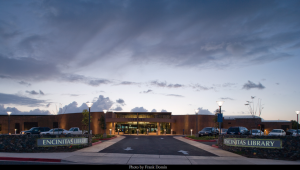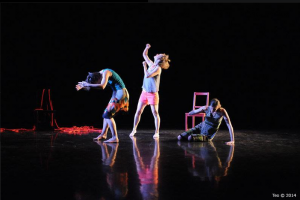IMAGOmoves’ “Mapping Games” Puts New Venue on the Map
 You could do a terrific San Diego architectural tour just by visiting public libraries designed by La Jolla-based Manuel Oncina. Oncina’s libraries, many of them award-winners, include branches in Fallbrook, Pacific Beach, Ramona, and Valencia Park (the stunning Malcolm X Library). He also designed the Encinitas Community Library, and one of the pleasures of IMAGOmoves’ show there on Saturday was sitting in the expansive gallery-performance space, looking out over a wide terrace at the tops of palm trees silhouetted against a just-after-sunset sky. Kudos to IMAGOmoves director Yolande Snaith for finding this lovely new venue for dance.
You could do a terrific San Diego architectural tour just by visiting public libraries designed by La Jolla-based Manuel Oncina. Oncina’s libraries, many of them award-winners, include branches in Fallbrook, Pacific Beach, Ramona, and Valencia Park (the stunning Malcolm X Library). He also designed the Encinitas Community Library, and one of the pleasures of IMAGOmoves’ show there on Saturday was sitting in the expansive gallery-performance space, looking out over a wide terrace at the tops of palm trees silhouetted against a just-after-sunset sky. Kudos to IMAGOmoves director Yolande Snaith for finding this lovely new venue for dance.
The pleasure continued in the opening section of “the mapping games (part 1),” a solo in which Snaith stood behind a chair and, with gorgeous hand gestures and impeccable attention, seemed to shape a sculpture that sat on the chair. According to the program notes, the piece grew out of creating choreographic maps of the dancers’ “home environments and personal identities;” Snaith initially trained in visual art, and, as she patted and molded, you could picture the forms she was creating.
Snaith conjured music, as well as art; as if she were playing a theremin, stronger gestures seemed to elicit more explosive burbles in Splash Yang’s sound design. Moving away from the chair, she did swoops and grounded lunges, at first with T’ai Chi-like deliberation and then more quickly swiveling and rolling, but still maintaining an inner focus, so that watching her had the centering effect of doing meditation. 
Following Snaith’s solo, the remainder (75-80%) of the piece involved Heather Glabe, Alison Dietterle Smith, and Sadie Weinberg doing a structured improvisation reflecting their own mapmaking. Here, too, sound was intriguingly integrated with the movement. Sitting at a table, Glabe moved around some two dozen green and white things that I thought of as stones from the Chinese game Go, shoving them over the table to loud clatters in the score.
Glabe, Smith, and Weinberg are all consummate movers, and there were some interesting moments, for instance, when Smith and Weinberg seemed to measure space with their arms, or Glabe supported Smith over one knee. Smith played with a prop, a thick red rope attached to a structure on the terrace, for a strong visual effect. There weren’t enough such moments, however. And the quality of deliberateness that struck me as meditative in Snaith’s solo, felt static and uninvolving here. That goes double for a section in which they played with kitchen objects.
At one point, for just five or ten seconds, the dancers did unison wavy movements with their hands. That bit of more intentional choreography, amid the improvisation, made me so happy! And it leads me to think that while it’s great, while generating ideas for a dance, to have everyone contribute material, democratic process can only take you so far. Snaith’s solo material was delicious, and the rest of this piece would have benefited from her exercising a stronger authorial hand.

Award-winning dance journalist Janice Steinberg has published more than 400 articles in the San Diego Union-Tribune, Dance Magazine, the Los Angeles Times, and elsewhere. She was a 2004 New York Times-National Endowment for the Arts fellow at the Institute for Dance Criticism and has taught dance criticism at San Diego State University. She is also a novelist, author of The Tin Horse (Random House, 2013). For why she’s passionate about dance, see this article on her web site, The Tin Horse
